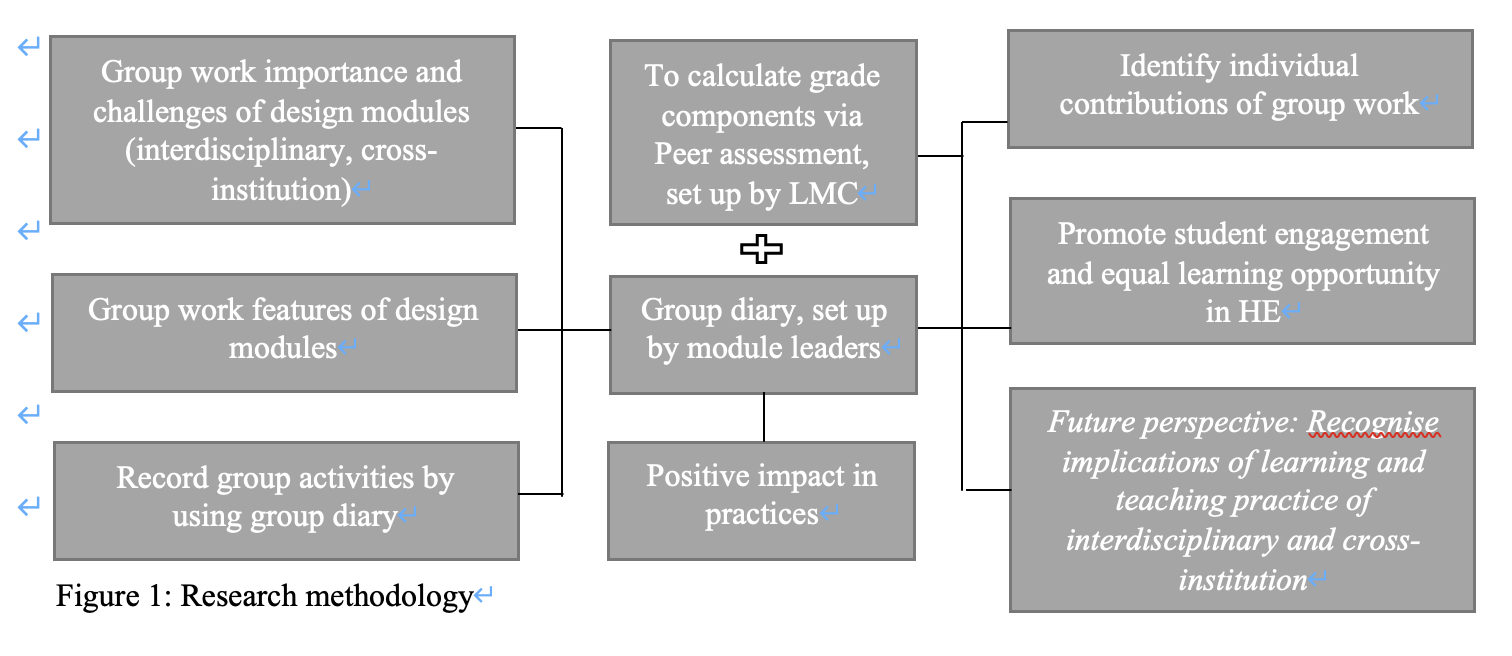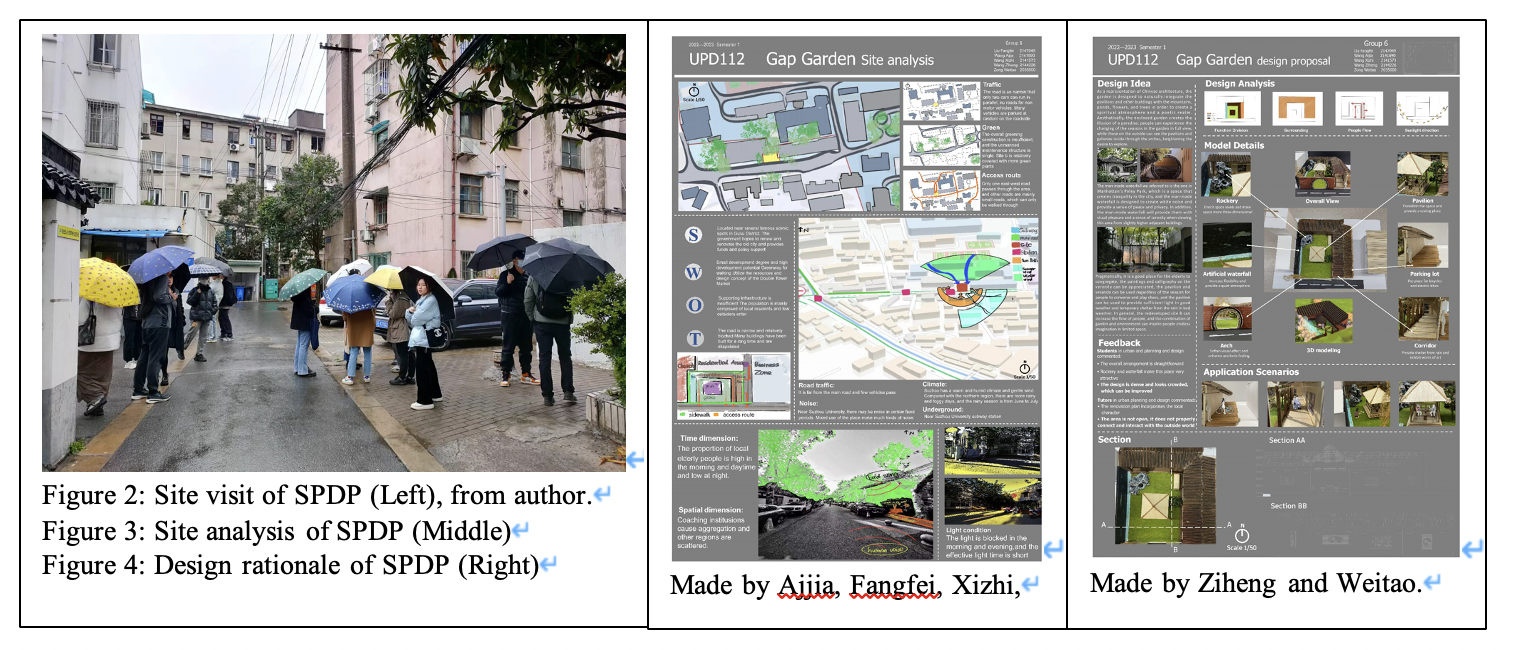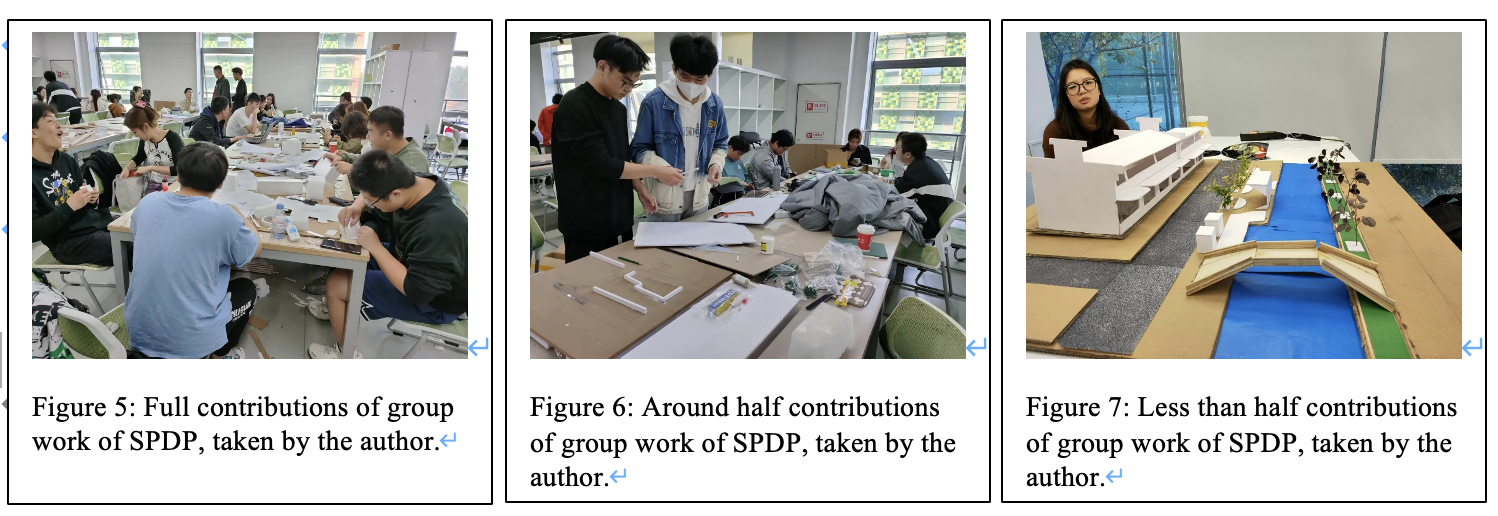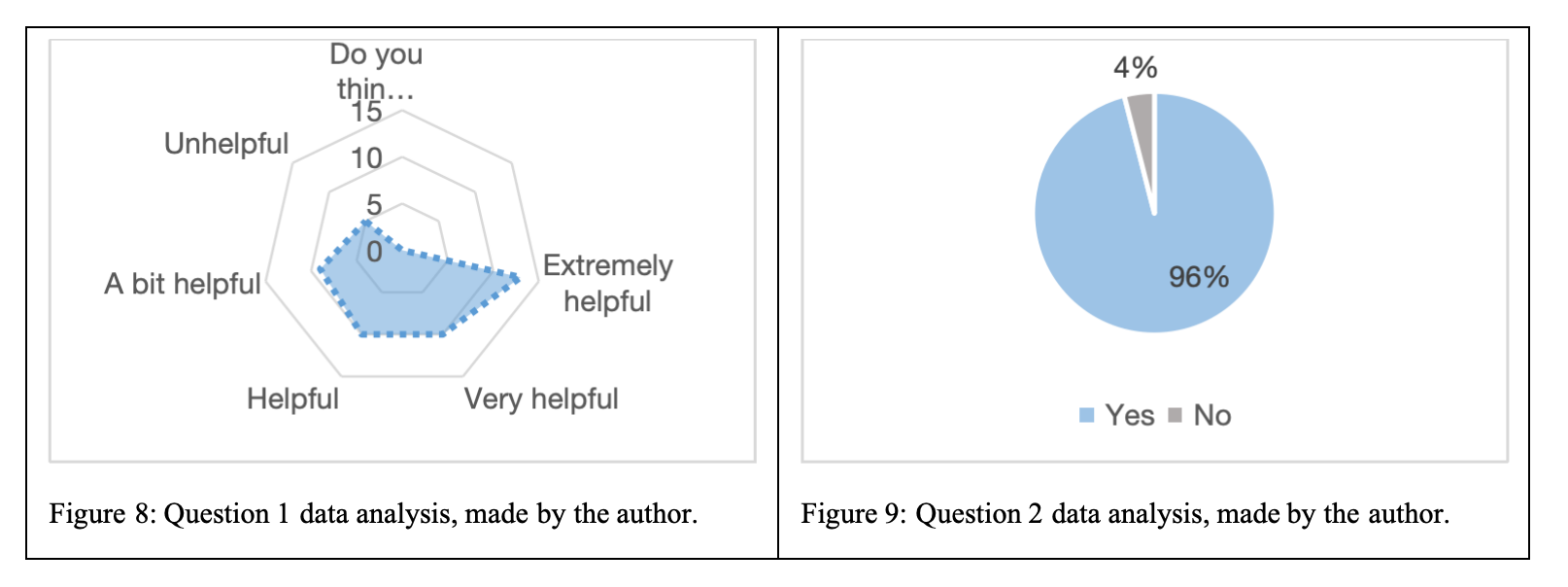For the template of the Group Diary, please refer to the link here.
Abstract:
Group work is essential to Higher Education (HE) design modules. Evaluating the genuine contributions of individual group members has become a significant challenge, especially in the studio-based design module where students engage in extensive group activities, including group meetings, site visits, photo-taking, model-making, visualising the final design, etc. Many of these activities occur outside of class, beyond the observation of the teaching staff. How can students be better engaged in their group work? How can module leaders accurately assess the individual contributions to the group work? This research explores a proactive approach that can promote student engagement in group work. A group diary template and peer assessment on the LM have been developed to identify authentic individual contributions. Its effectiveness has been initially examined in design modules and will be further validated across different disciplines and institutions.
1 Introduction
1.1 Background
The importance of group work as a form of assessment has long been recognised among educators (Martin Davies, 2009). A predominance of research findings continues to show the positive effects of group methods on student achievement, especially compared to other forms of instruction that involve less interaction between students (e.g. O’Donnell, 2006; Slavin, 1995). Group work promotes “active” as opposed to “passive” learning (Kremer and McGuiness 1998; Ruel et al. 2003). In addition, group work can promote interpersonal relationships among students, stimulate their interest in research topics, and enhance their problem-solving abilities (Hughes, 2023).
Researchers have documented various communication difficulties in groups negatively related to group and individual outcomes (Webb, 2010). Barron (2003) has identified the lack of coordination among group members’ efforts and participation as an impediment to group functioning and individual learning. Kokemuller (2007) also indicates that some students may dominate over others in group work, while others stop contributing or being “free-riders”.
Student peer assessment is often used for group work to cope with the above issue. As we have noticed in learning and teaching, some students assess others’ performance subjectively, and a few students show less interest in submitting the peer assessment. The situation has resulted in other challenges for module leaders.
How can students be better engaged in their group work? How can module leaders assess the individual contributions to the group work? The exploration can promote participation in higher education and equal opportunity for learners, use evidence-informed approaches for continuing professional development and acknowledge the wider context in which higher education operates and recognise the implications for professional practice, as shown in the V2, V3, and V4 in the UKPSF (2023). The reflections can help ensure good practice in teaching and supporting learning and excellent student experience in HE.
1.2 Research methodology and design
This research mainly focuses on qualitative research method, including literature review, observation, diary statements and questionnaire. It explores the importance and challenges of group work in design modules at the XJTLU Design School and relevant comparable HE institution through literature review and observation. Based on that, group work features of design modules were analysed as well. Inspired by a personal diary, a group diary can be applied to record group activities outside class. In design modules, each group could be required to fill out a group diary to identify individual contributions. Combining the collected group diary statements and peer assessment set up by the LM, it can help module leaders calculate grade components to promote student engagement and equal learning opportunity in HE. The process creates a positive impact on practical group work of design modules at XJTLU However, the research needs further implications of learning and teaching practice of interdisciplinary and cross-institution in the future by collecting more group diary statements and interviews with module leaders of design modules.

Note: UKPSF is the UK Professional Standards Framework. This is a framework used in many parts of the world to support and recognize staff development and benchmark success in teaching and learning in higher education. The current applied version is UKPSF 2023, the outcome of a sector-wide consultation with over 800 academics and higher education professionals from more than 20 countries. The resource is available at https://www.advance-he.ac.uk/knowledge-hub/uk-professional-standards-framework-ukpsf.
2 The group diary story
Based on Year 2, Year 3, and Master design modules at UPD and ARC in XJTLU, as well as comparable design modules at the School of Architecture at Tsinghua University. There was group work and individual work. Group work faces more challenges than individual work for students in terms of the conversation with module leaders of design modules, and supported by the literature review in the part of the introduction.
This paper takes the Year 2 cohort at UPD for study. The students selected various modules in Year 1. Therefore, they were unfamiliar with each other when they progressed to Year 2. The random grouping approach was suitable for students However, groups had many arguments and disagreements during the learning and teaching process. Some group members did complain that other group members made less or even no contribution to the group work, for example, the “free-rider” problem, less engagement, lower graphic quality, etc. Students were worried about the final marks due to the above problems. On one hand, Year 2 students need guidance to work better as a team. On the other hand, a suitable solution should be explored to push students to contribute more to their group work. Before exploring a suitable solution, it is important to identify the features of the design module.
3 Design module features

Arguably, different modules vary in features, depending on the purpose or learning outcomes of learning and teaching activities. According to Obeidat and Al-Share (2012), a design studio is a place for accommodating design teaching and learning activities and where student-student and student-instructor interaction occurs. They also claimed that students had to spend extra time in a design module and formulate social/academic interactions. In fact, in group work of a design module, students need to discuss the issues of site visit (see Figure 2), site analysis (see Figure 3), case studies, design concepts, design strategies, physical-model making (see Figure 5-7), coursework outputs (see Figure 3-4), and so on, with their group members beyond the teaching sessions. This means that design module leaders can only observe what happened in the class but cannot know very much out of the class. The contribution level to group work would directly affect the quality of final outcomes as many time-consuming workloads have to be shared properly. If all the group members can contribute what they can, the final outcomes will be of high quality. However, if only a few group members can make a significant contribution, the quality of final outcomes would most likely be dragged down. Actually, some differences did exist. For example, some groups were cooperating very well, while some groups had one or more than one member who could not engage as expected (see Figure 5-7).

4 Group diary approach
During the teaching sessions, it was necessary to help students work better as a team and find suitable solutions to push them to contribute more to their group outputs. Basically, the action plan was inspired by a personal diary where people recorded daily activities/events, thoughts and feelings about personal experiences or opinions. According to Collins Dictionary (2023), people can use a diary to write down things he/she plan to do or record what happens in his/her life day by day. Cambridge Dictionary (2023) defines a diary as a record of what has happened during a period of time about events, thoughts, feelings, etc.
Correspondingly, one group can use a group diary to record group facts reflecting an individual’s contributions. Group leaders were therefore asked to submit a group diary on the LM (Learning Mall after their submissions to document group facts, such as detailed information on attendance of site visits, photographing, site analysis, model making, planning/design engagement, attendance of discussions, poster contributions, and other group activities in class and beyond (see Appendix 1). It has been proved that all groups were happy to submit a group diary to show their individual authentic contributions to their group work.
Students were required to submit diary statements to show their individual contributions to the group work. This diary was used to aid the peer assessment and was set up on the LM (XJTLU account). Most groups recorded their group activities using tables and text to describe if each group member participated fully or at other levels of participation. All group members should agree with each other on the recorded facts and finalise a document of the group diary, which was submitted by group leaders.
When module leaders assess an individual contribution, two types of evidence would be helpful: student peer assessment and a group diary. Even if group members offered peer assessment subjectively, they also could reflect on what they had done in the group diary. The idea that a few students tried not to respect reality could likely be avoided and modified based on the observation from module leaders and part-time tutors. This can engage students who are reluctant to contribute much to do more instead of playing a similar role as “free riders”.
5 Impact of group diary in practice
There are two main points to display the above impacts, as described in the following.
First is the impact on learning and teaching. This approach has promoted student engagement with a 100% submission rate for group work. The design module was flagged for higher module averages for students than the last academic year. In addition, the group diary provided solid evidence by combining it with peer assessment on the LM to better judge the individual contributions and thereby decide the marking difference or similarity for their group work.
Second, the External Examiner, the Department, and the DES have highly commended this group diary approach. The External Examiner claims that she is pleased to see the diary-type statements supporting peer assessment and an emerging reflection by students on their work and group behaviour, which is a good start and could be further developed. Furthermore, the Department Exam Board has also recognised diary statements as a good practice for student peer assessment. Moreover, the practice has received a Learning & Teaching award from DES in AY2022-23.
6 Discussion
Two points are discussed in this session. The first is continuously employing a group diary to explore if the group diary template would be appropriate. The second is discussing comments filled out by the students who recorded the group activities using the template.
6.1 Continuous employment of group diary
Based on the positive feedback of the group diary for aiding peer assessment, the approach has been continuously employed by a Year 3 design module of Urban Design and Theory II (UDT). To avoid the various formats of the group diary, a template was created and used for year 3 students (see Appendix 1), which could help students fill it quickly with a standardised format and help module leaders quickly review it. All groups were required to complete the template by agreeing with each other before submitting it to the LM.
Again, the approach has promoted the student engagement of a 100% submission rate for group work of this design module. The students’ performance was satisfactory, and the module average mark was 1 point higher than last academic year. The External Examiner and the Department Exam Board further acknowledged a diary approach in the module marking moderation report. The employment of a group diary to aid peer assessment of UDT has reflected V2, V3, and V4 of UKPSF (please see the relevant part of 1.1.).
6.2 Data analysis
A questionnaire was applied to further collect feedback from students about group diaries. This questionnaire invited students of year 2 and year 3 in UPD as the two design modules employed the approach of group diary to aid peer assessment. 87 students participated in this survey (more than half of the cohort) and all questionnaires were valid.
The first question is, “Do you think a group diary is helpful in identifying the individual contributions of your group members?” Almost 100% of students claimed that the group diary was helpful (see Figure 8), demonstrating positive feedback to encourage future exploration. The second question is, “Do you think the group diary can reflect authentic facts/activities related to your group work?” Around 96% of students suggested that a group diary could reflect what had happened in their group work (see Figure 9). The remaining 4% suggested that the group diary should be improved more to guarantee 100% accurate reflection.

The third question is, “Do you prefer to have a template of a group diary to follow?” Around 91% of students preferred to employ a group diary template. The fourth question is, “Do you think a group diary can be used for the other design studios within the Design School?” 85% of students selected yes, while 15% selected no. This acknowledges the potential implementation of group diary in a wider context where higher education operates and recognises the implications for professional practice, shown in the V4 of UKPSF (2023). However, it should be further explored in the future.

The last question was open, which asked students to specify any suggestions. Most students thought that group diary practice was very good or great. There were two main suggestions: one was that the template should be issued earlier as students need to record their group activities when group work starts; the other was to better clarify the overlapped group work. These two ideas were helpful for the further improvement of the group diary.
According to the above discussion, student peer assessment by employing a group diary is a good practice to promote student engagement of group work in design modules.
7 Conclusion
The practice of group diary combining peer assessment on the LM has obtained positive feedback from students, the University, and the External Examiners. Students made a higher submission rate after employing a group diary for their group work and offered positive comments about it in the questionnaire. The External Examiner highly commended the group diary on the e-Bridge. It mainly reflects V2, V3, and V4 of UKPSF. In addition, it has also reflected Gibb’s reflective cycle (Gibbs, 1988) and Kolb’s learning cycle (Kolb, 1984). However, three main research limitations have been identified below.
First, a few students mentioned that the group diary did not truly record facts of group work because they did not want to be too harsh to group members who made marginal or even no contributions to group work. Observations from module leaders could be considered to add to help them record indeed.
Second, this essay has yet to investigate the difference between different year levels. For example, the situation might change if senior students selected group members by themselves. They might have fewer arguments and disagreements than fresh students. The main reason was that senior students knew each other better and had more teamwork experiences. As a result, fewer groups had big differences based on their individual mark of group work. Future research should further identify how the template would be modified according to different year levels.
Third, this practice needs to be tested with a wider range in the future, for example, in other departments within Design School and beyond XJTLU, like Tsinghua University. This point is ongoing with the support from a TDF titled “Group diary in team assessment: the impact on student engagement and peer evaluation practice in design studios”.
In summary, this will be investigated in depth in the future. For example, a further modified template of a group diary can be applied in a wider context by interviews with students and module leaders of design modules.
Note:
This research is supported by the XJTLU Teaching Development Fund (TDF-22/23-R26-218).
Reference:
Cambridge Dictionary, 2023, Diary, available at https://dictionary.cambridge.org/dictionary/english/diary, accessed at 01/06/2023.
Collins Dictionary, 2023, Diary, available at https://www.collinsdictionary.com/dictionary/english/diary, accessed at 01/06/2023.
EDU, 2023, PGCert 402 lectures, available at LM webpage.
Gibbs, G., (1988), Learning by doing: a guide to teaching and learning methods, Further Education Unit, Oxford Polytechnic: Oxford.
Hughes, D. (2023), ‘The case for team-based learning in higher education scriptwriting programmes: a narrative literature review’, Journal of Screenwriting, 14(1), pp.59-73. Doi: 10.1386/josc_00115_1.
Kolb, D.A., (1984), Experiential learning: experience as the source of learning and development (Vol.1.), Englewood Cliffs, NJ: Prentice-Hall.
Kremer, J., & McGuiness, C. 1998, Cutting the cord: student-led discussion groups in higher education. Education + Training, 40 (2), 44-49.
Martin Davies, W. 2009, Groupwork as a form of assessment: common problems and recommended solutions, Higher Education, Google Scholar.
Obeidat, A. and Al-Share, R., 2012, Quality learning environments: design-studio classroom, Google Scholar.
O’Donnell, A.M. 2006, The role of peers and group learning, P. Alexander, P. Winne Handbook of educational psychology, 2nd ed. Mahwah, NJ Lawrence Erlbaum.
Ruel, G., Bastiaans, N., & Nauta, A. 2003, Free riding and team performance in project education. International Journal of Management Education, 3(1), 26-38,
Slavin, R.E. 1995, Cooperative learning, 2nd ed. Boston, MA Allyn and Bacon.
UKPSF, 2023, The UKPSF dimensions of the framework, available at https://www.advance-he.ac.uk/teaching-and-learning/psf, accessed at 26/05/2023.






